TOYOTA HIGHLANDER HYBRID 2019 (in English) Manual Online
Manufacturer: TOYOTA, Model Year: 2019, Model line: HIGHLANDER HYBRID, Model: TOYOTA HIGHLANDER HYBRID 2019Pages: 716, PDF Size: 14.31 MB
Page 81 of 716
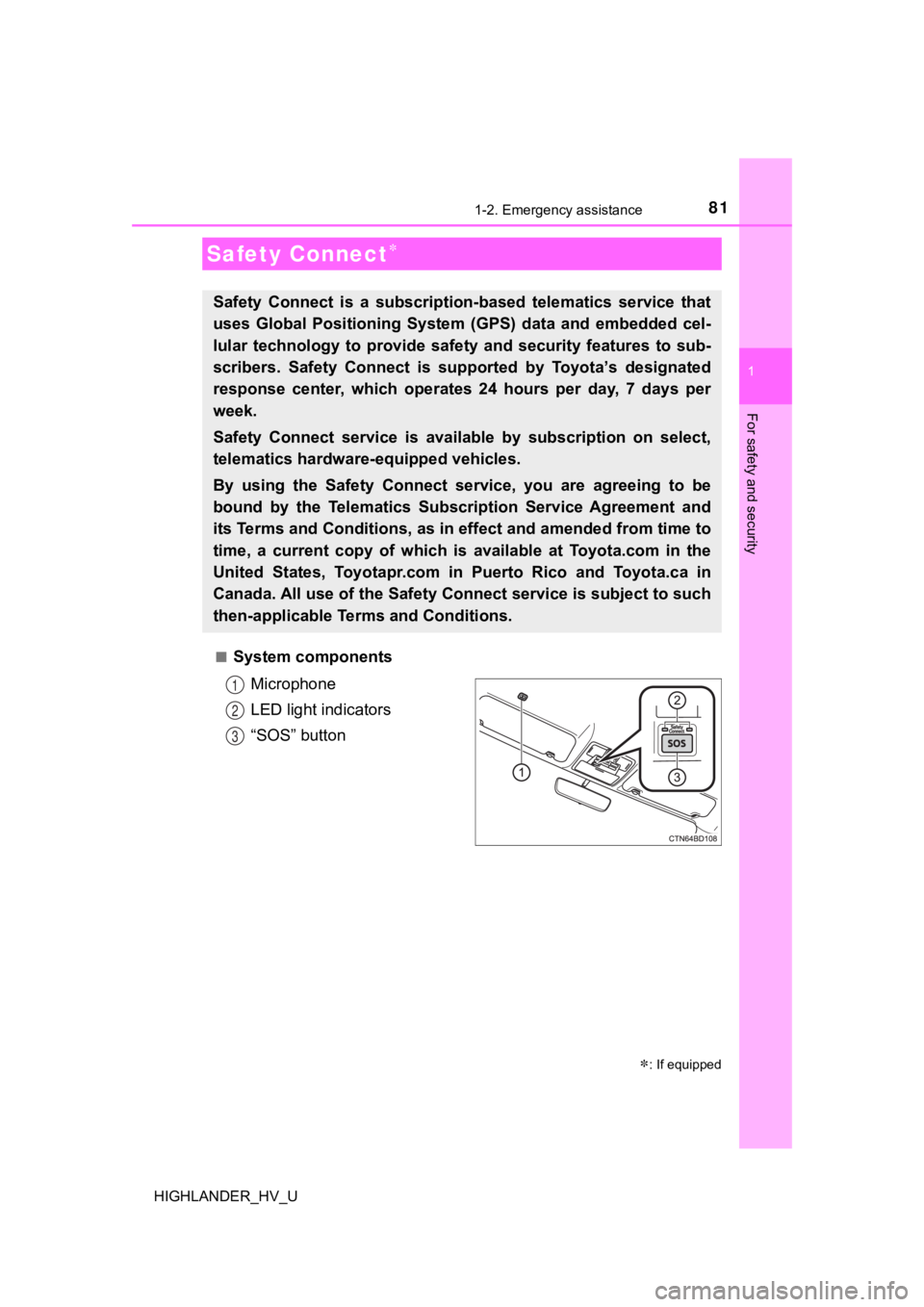
81
1
For safety and security
HIGHLANDER_HV_U
1-2. Emergency assistance
â– System componentsMicrophone
LED light indicators
“SOS” button
Safety Connect
: If equipped
Safety Connect is a subscription-based telematics service that
uses Global Positioning System ( GPS) data and embedded cel-
lular technology to provide saf ety and security features to sub -
scribers. Safety Connect is s upported by Toyota’s designated
response center, which operates 24 hours per day, 7 days per
week.
Safety Connect service is avai lable by subscription on select,
telematics hardware -equipped vehicles.
By using the Safety Connect service, you are agreeing to be
bound by the Telematics Subscription Service Agreement and
its Terms and Conditions, as in e ffect and amended from time to
time, a current copy of which is available at Toyota.com in the
United States, Toyotapr.com in Puerto Rico and Toyota.ca in
Canada. All use of the Safety Connect service is subject to suc h
then-applicable Terms and Conditions.
1
2
3
Page 82 of 716

821-2. Emergency assistance
HIGHLANDER_HV_Uâ–
Services
Subscribers have the following Safety Connect services availabl
e:
â—Ź Automatic Collision Notification
*
Helps drivers receive necessary response from emergency ser-
vice providers. ( ď‚®P. 8 4 )
*: U.S. Patent No. 7,508,298 B2
â—Ź Stolen Vehicle Location
Helps drivers in the eve nt of vehicle theft. (ď‚®P. 85)
â—Ź Emergency Assistance Button (SOS)
Connects drivers to response-center support. ( ď‚®P. 8 5 )
â—Ź Enhanced Roadside Assistance
Provides drivers various on-road assistance. (ď‚®P. 8 5 )
â– Subscription
After you have signed the Telemati cs Subscription Service Agree-
ment and are enrolled, you c an begin receiving services.
A variety of subscription terms are available for purchase. Con tact
your Toyota dealer, call the following appropriate Safety Conne ct
response center or push the “SOS ” button in your vehicle for further
subscription details.
• The United States 1-855-405-6500
• Canada
1-888-869-6828
• Puerto Rico 1-877-855-8377
Page 83 of 716
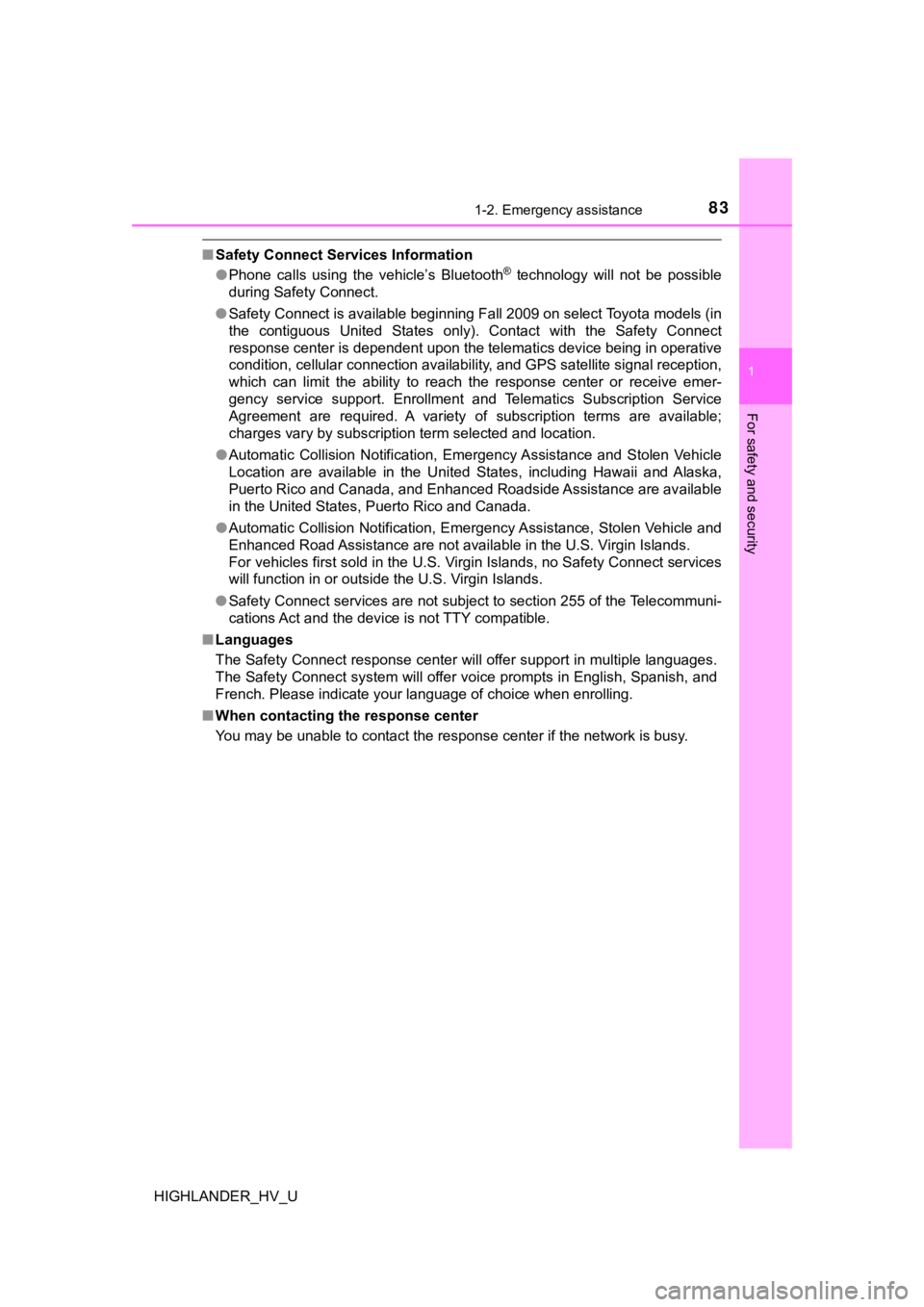
831-2. Emergency assistance
1
For safety and security
HIGHLANDER_HV_U
â– Safety Connect Services Information
●Phone calls using the vehicle’s Bluetooth® technology will not be possible
during Safety Connect.
â—Ź Safety Connect is available beginning Fall 2009 on select Toyot a models (in
the contiguous United States only). Contact with the Safety Con nect
response center is dependent upon the telematics device being i n operative
condition, cellular connection availability, and GPS satellite signal reception,
which can limit the ability to reach the response center or rec eive emer-
gency service support. Enrollment and Telematics Subscription S ervice
Agreement are required. A variety of subscription terms are ava ilable;
charges vary by subscription term selected and location.
â—Ź Automatic Collision Notification, Emergency Assistance and Stolen Vehicle
Location are available in the United States, including Hawaii a nd Alaska,
Puerto Rico and Canada, and Enhanced Roadside Assistance are av ailable
in the United States, Puerto Rico and Canada.
â—Ź Automatic Collision Notification, Emergency Assistance, Stolen Vehicle and
Enhanced Road Assistance are not available in the U.S. Virgin I slands.
For vehicles first sold in the U.S. Virgin Islands, no Safety C onnect services
will function in or outside the U.S. Virgin Islands.
â—Ź Safety Connect services are not subject to section 255 of the T elecommuni-
cations Act and the device is not TTY compatible.
â– Languages
The Safety Connect response center will offer support in multip le languages.
The Safety Connect system will offer voice prompts in English, Spanish, and
French. Please indicate your language of choice when enrolling.
â– When contacting the response center
You may be unable to contact the response center if the network is busy.
Page 84 of 716
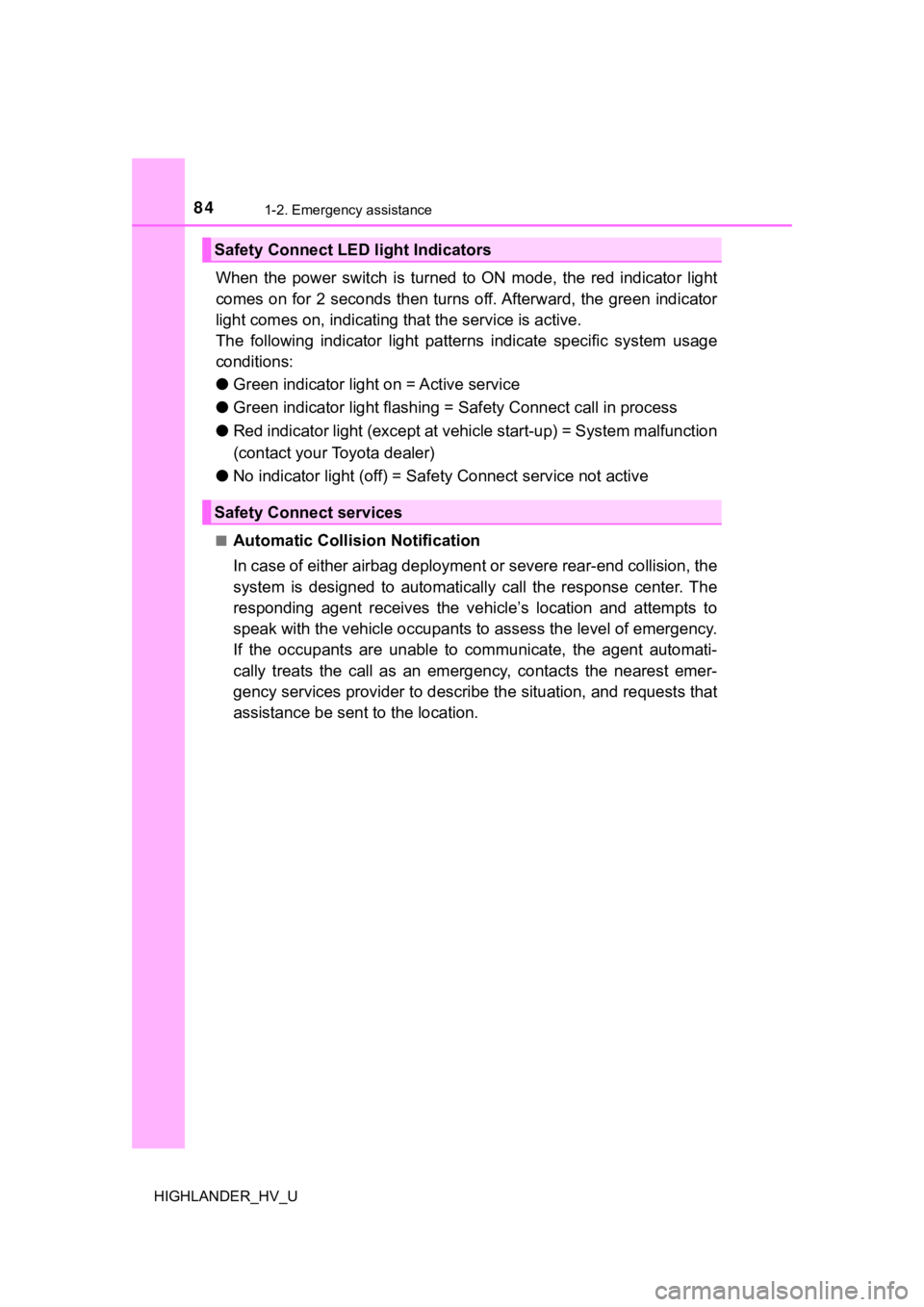
841-2. Emergency assistance
HIGHLANDER_HV_U
When the power switch is turned to ON mode, the red indicator light
comes on for 2 seconds then turns off. Afterward, the green ind icator
light comes on, indicating t hat the service is active.
The following indicator light patterns indicate specific system usage
conditions:
â—Ź Green indicator light on = Active service
â—Ź Green indicator light flashing = Safety Connect call in process
â—Ź Red indicator light (except at vehicle start-up) = System malfunction
(contact your Toyota dealer)
â—Ź No indicator light (off) = Saf ety Connect service not active
â– Automatic Collision Notification
In case of either airbag deployme nt or severe rear-end collision, the
system is designed to automatically call the response center. T he
responding agent receives the v ehicle’s location and attempts to
speak with the vehicl e occupants to assess the level of emergency.
If the occupants are unable to communicate, the agent automati-
cally treats the call as an emergency, contacts the nearest eme r-
gency services provider to descr ibe the situation, and requests that
assistance be sent to the location.
Safety Connect LED light Indicators
Safety Connect services
Page 85 of 716
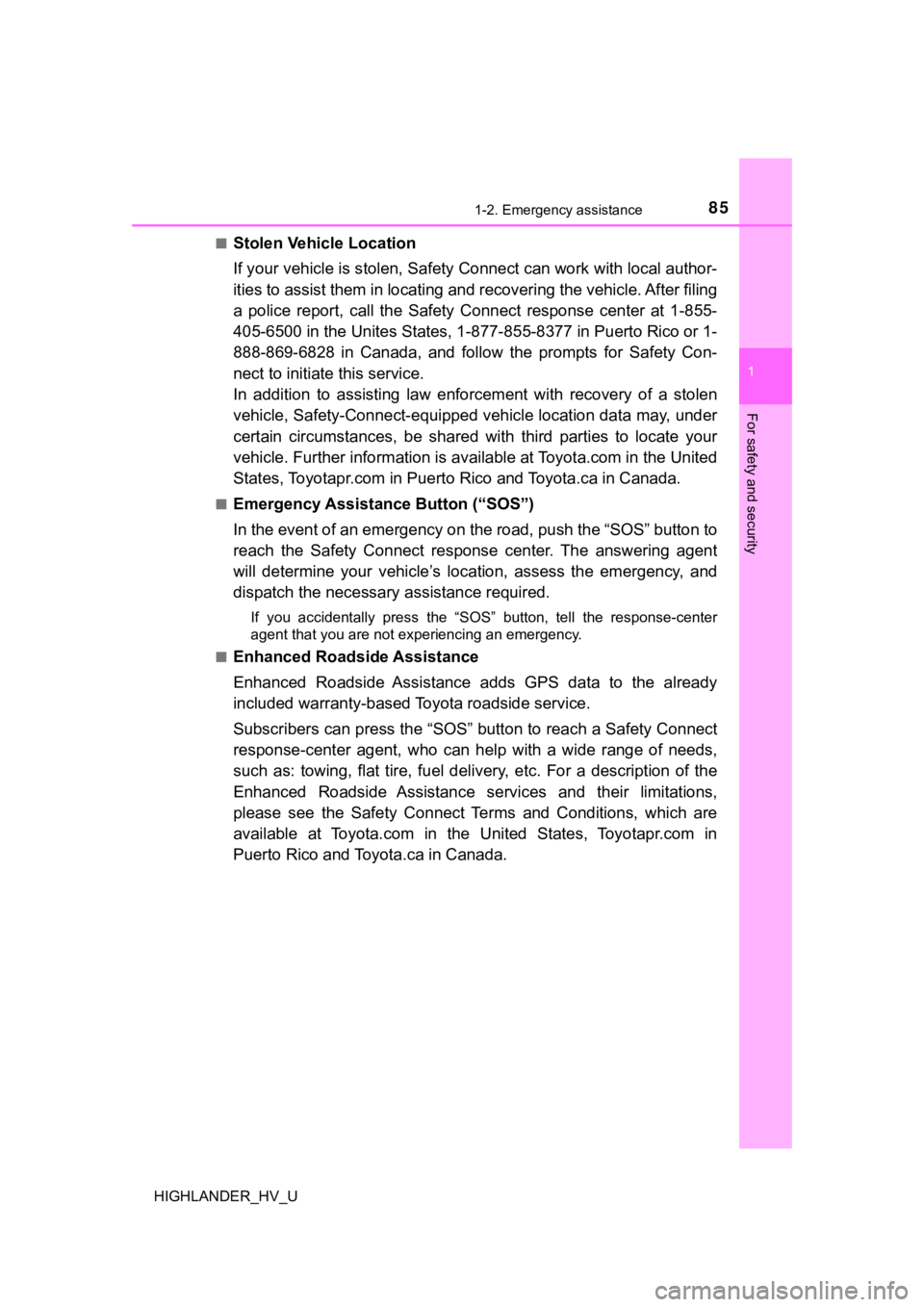
851-2. Emergency assistance
1
For safety and security
HIGHLANDER_HV_Uâ–
Stolen Vehicle Location
If your vehicle is stolen, Safety
Connect can work with local author-
ities to assist them in locating and recovering the vehicle. Af ter filing
a police report, call the Safety Connect response center at 1-8 55-
405-6500 in the Unites States, 1-877-855-8377 in Puerto Rico or 1-
888-869-6828 in Canada, and follow the prompts for Safety Con-
nect to initiate this service.
In addition to assisting law enforcement with recovery of a sto len
vehicle, Safety-Connect-equipped vehicle location data may, und er
certain circumstances, be shared with third parties to locate y our
vehicle. Further information is a vailable at Toyota.com in the United
States, Toyotapr.com in Puerto Rico and Toyota.ca in Canada.
■Emergency Assistance Button (“SOS”)
In the event of an emergency on t he road, push the “SOS” button to
reach the Safety Connect respons e center. The answering agent
will determine your vehicle’s loca tion, assess the emergency, and
dispatch the necessary assistanc e required.
If you accidentally press the “SOS” button, tell the response-c enter
agent that you are not experiencing an emergency.
â–
Enhanced Roadside Assistance
Enhanced Roadside As sistance adds GPS data to the already
included warranty-based Toyota roadside service.
Subscribers can press the “SOS” button to reach a Safety Connec t
response-center agent, who can he lp with a wide range of needs,
such as: towing, flat tire, fuel delivery, etc. For a description of the
Enhanced Roadside Assistance se rvices and their limitations,
please see the Safety Connect Te rms and Conditions, which are
available at Toyota.com in the United States, Toyotapr.com in
Puerto Rico and Toyota.ca in Canada.
Page 86 of 716

861-2. Emergency assistance
HIGHLANDER_HV_U
Important! Read this information before using Safety Connect.
â– Exposure to radio frequency signals
The Safety Connect system installed in your vehicle is a low-po wer
radio transmitter and receiver. I t receives and also sends out radio
frequency (RF) signals.
In August 1996, the Federal Communications Commission (FCC)
adopted RF exposure guidelines with safety levels for mobile wi re-
less phones. Those guidelines are consistent with the safety stan-
dards previously set by the following U.S. and international
standards bodies.
â—Ź ANSI (American National Stand ards Institute) C95.1 [1992]
â—Ź NCRP (National Council on Radi ation Protection and Measure-
ment) Report 86 [1986]
â—Ź ICNIRP (International Commission on Non-Ionizing Radiation
Protection) [1996]
Those standards were based on comprehensive and periodic eval-
uations of the relevant scienti fic literature. Over 120 scientists, engi-
neers, and physicians from unive rsities, and government health
agencies and industries reviewed the available body of research to
develop the ANSI Standard (C95.1).
The design of Safety Connect complies with the FCC guidelines i n
addition to those standards.
â– Certification for Safety Connect
FCC ID: LHJ-TVN
NOTE:
This device complies with Part 15 of the FCC Rules. Operation i s subject to
the following two conditions: (1) This device may not cause har mful interfer-
ence, and (2) this device must accept any interference received, including
interference that may cause undesired operation.
FCC WARNING:
Changes or modifications not expressly approved by the party re sponsible for
compliance could void the user's authority to operate the equip ment.
Safety information for Safety Connect
Page 87 of 716
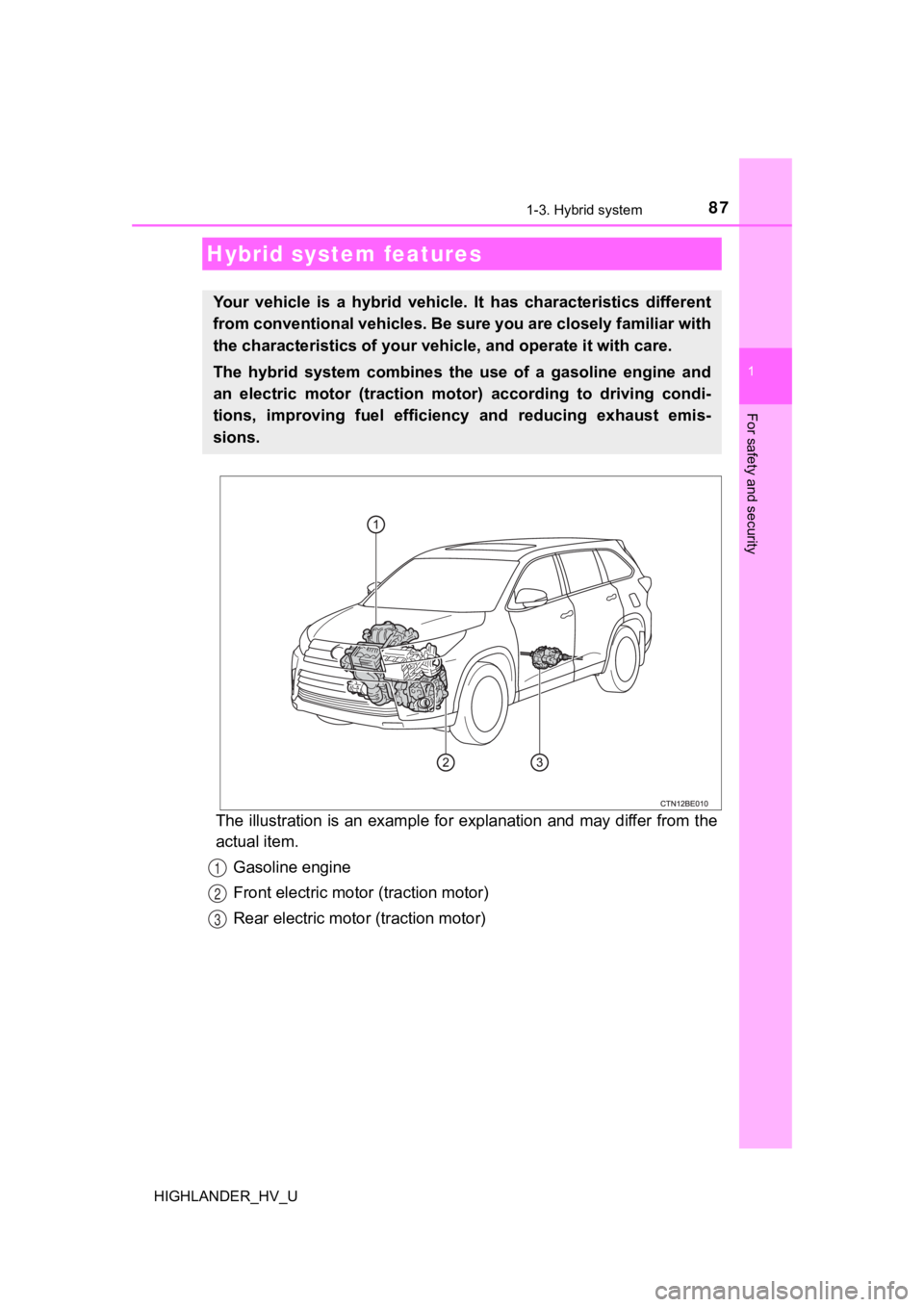
87
1
For safety and security
HIGHLANDER_HV_U
1-3. Hybrid system
The illustration is an example for explanation and may differ from the
actual item.
Gasoline engine
Front electric motor (traction motor)
Rear electric motor (traction motor)
Hybrid system features
Your vehicle is a hybrid vehicle. It has characteristics differ ent
from conventional vehicles. Be sure you are closely familiar wi th
the characteristics of your veh icle, and operate it with care.
The hybrid system combines the use of a gasoline engine and
an electric motor (traction motor) according to driving condi-
tions, improving fuel efficien cy and reducing exhaust emis-
sions.
1
2
3
Page 88 of 716
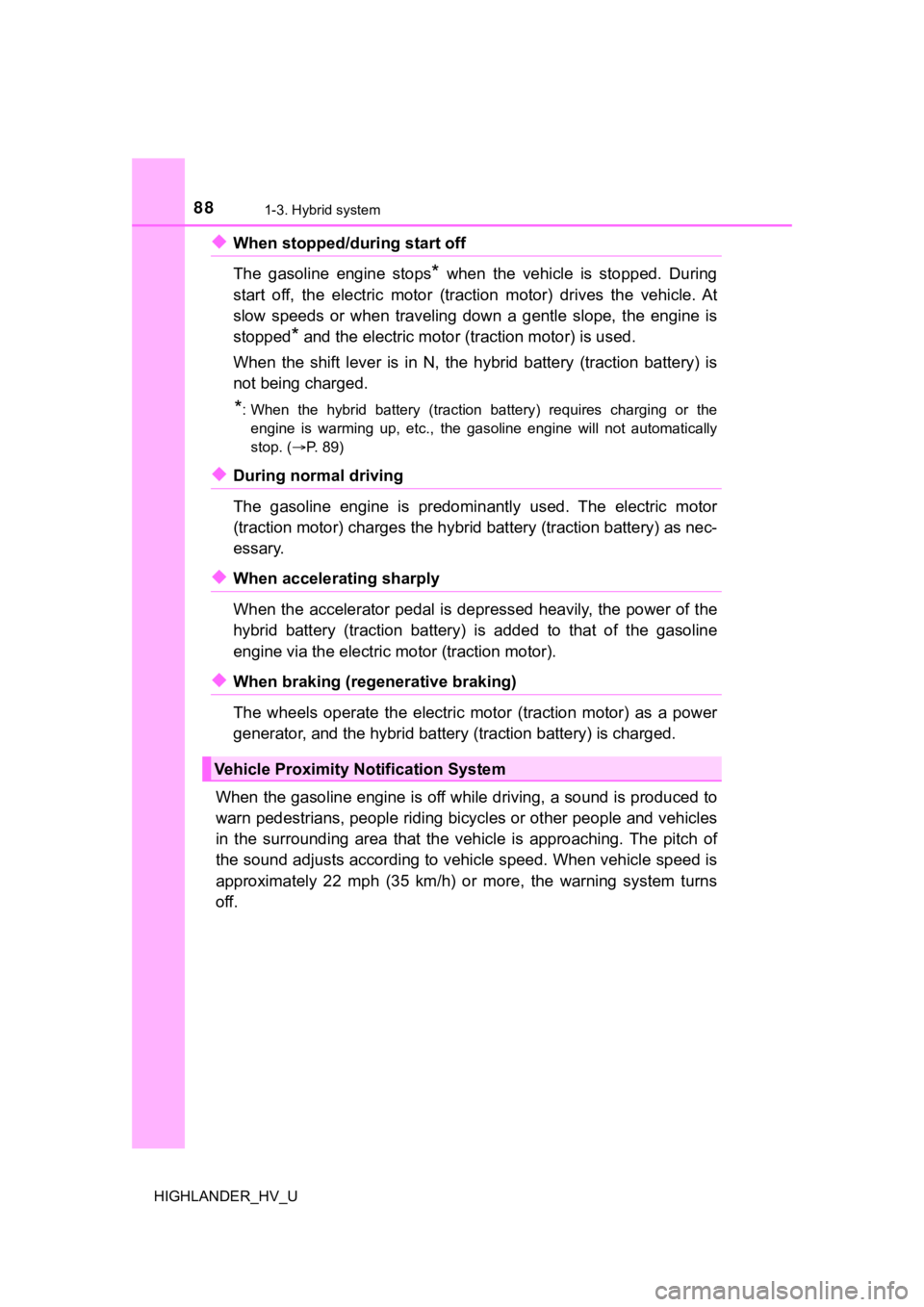
881-3. Hybrid system
HIGHLANDER_HV_U
â—†When stopped/during start off
The gasoline engine stops
* when the vehicle is stopped. During
start off, the electric motor (traction motor) drives the vehic le. At
slow speeds or when traveling down a gentle slope, the engine i s
stopped
* and the electric motor (traction motor) is used.
When the shift lever is in N, the hybrid battery (traction batt ery) is
not being charged.
*: When the hybrid battery (traction battery) requires charging or the
engine is warming up, etc., the gasoline engine will not automa tically
stop. ( ď‚®P. 89)
â—†During normal driving
The gasoline engine is predominantly used. The electric motor
(traction motor) charges the hybr id battery (traction battery) as nec-
essary.
â—†When accelerating sharply
When the accelerator pedal is depressed heavily, the power of t he
hybrid battery (traction battery) is added to that of the gasol ine
engine via the electric motor (traction motor).
â—†When braking (regenerative braking)
The wheels operate the electric motor (traction motor) as a pow er
generator, and the hybrid battery (traction battery) is charged.
When the gasoline engine is off while driving, a sound is produ ced to
warn pedestrians, people riding bicycles or other people and ve hicles
in the surrounding area that the vehicle is approaching. The pi tch of
the sound adjusts according to v ehicle speed. When vehicle spee d is
approximately 22 mph (35 km/h) or more, the warning system turn s
off.
Vehicle Proximity Notification System
Page 89 of 716
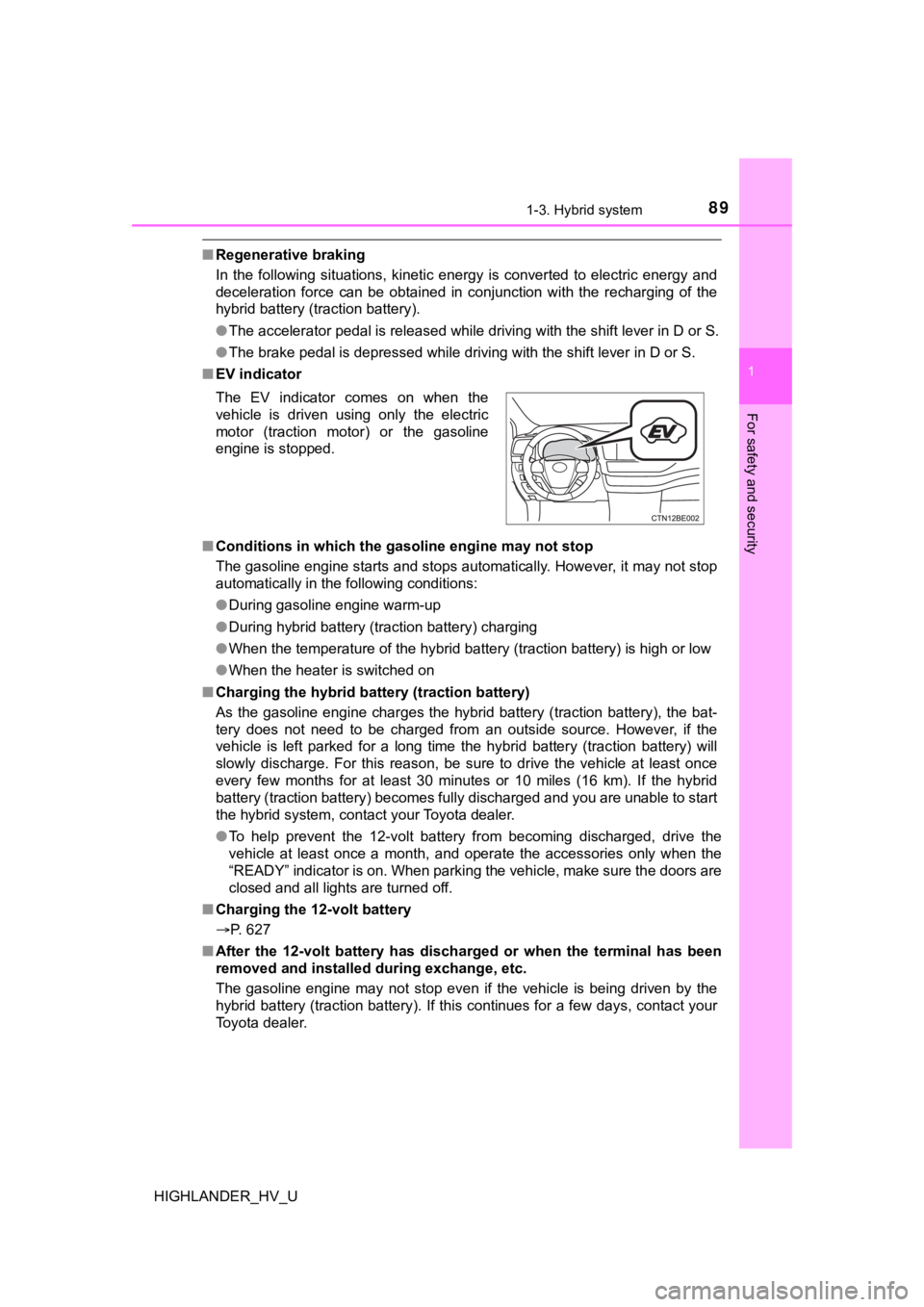
891-3. Hybrid system
1
For safety and security
HIGHLANDER_HV_U
â– Regenerative braking
In the following situations, kinetic energy is converted to electric energy and
deceleration force can be obtained in conjunction with the rech arging of the
hybrid battery (traction battery).
â—Ź The accelerator pedal is released while driving with the shift lever in D or S.
â—Ź The brake pedal is depressed while driving with the shift lever in D or S.
â– EV indicator
â– Conditions in which the gasoline engine may not stop
The gasoline engine starts and stops automatically. However, it may not stop
automatically in the following conditions:
â—Ź During gasoline engine warm-up
â—Ź During hybrid battery (traction battery) charging
â—Ź When the temperature of the hybrid battery (traction battery) is high or low
â—Ź When the heater is switched on
â– Charging the hybrid batt ery (traction battery)
As the gasoline engine charges the hybrid battery (traction bat tery), the bat-
tery does not need to be charged from an outside source. Howeve r, i f t h e
vehicle is left parked for a long time the hybrid battery (trac tion battery) will
slowly discharge. For this reason, be sure to drive the vehicle at least once
every few months for at least 30 minutes or 10 miles (16 km). I f the hybrid
battery (traction battery) becomes fully discharged and you are unable to start
the hybrid system, contact your Toyota dealer.
â—Ź To help prevent the 12-volt battery from becoming discharged, d rive the
vehicle at least once a month, and operate the accessories only when the
“READY” indicator is on. When parking the vehicle, make sure th e doors are
closed and all lights are turned off.
â– Charging the 12-volt battery
ď‚®P. 627
â– After the 12-volt battery has discharged or when the terminal h as been
removed and installed during exchange, etc.
The gasoline engine may not stop even if the vehicle is being driven by the
hybrid battery (traction battery). If this continues for a few days, contact your
Toyota dealer. The EV indicator comes on when the
vehicle is driven using only the electric
motor (traction motor) or the gasoline
engine is stopped.
Page 90 of 716
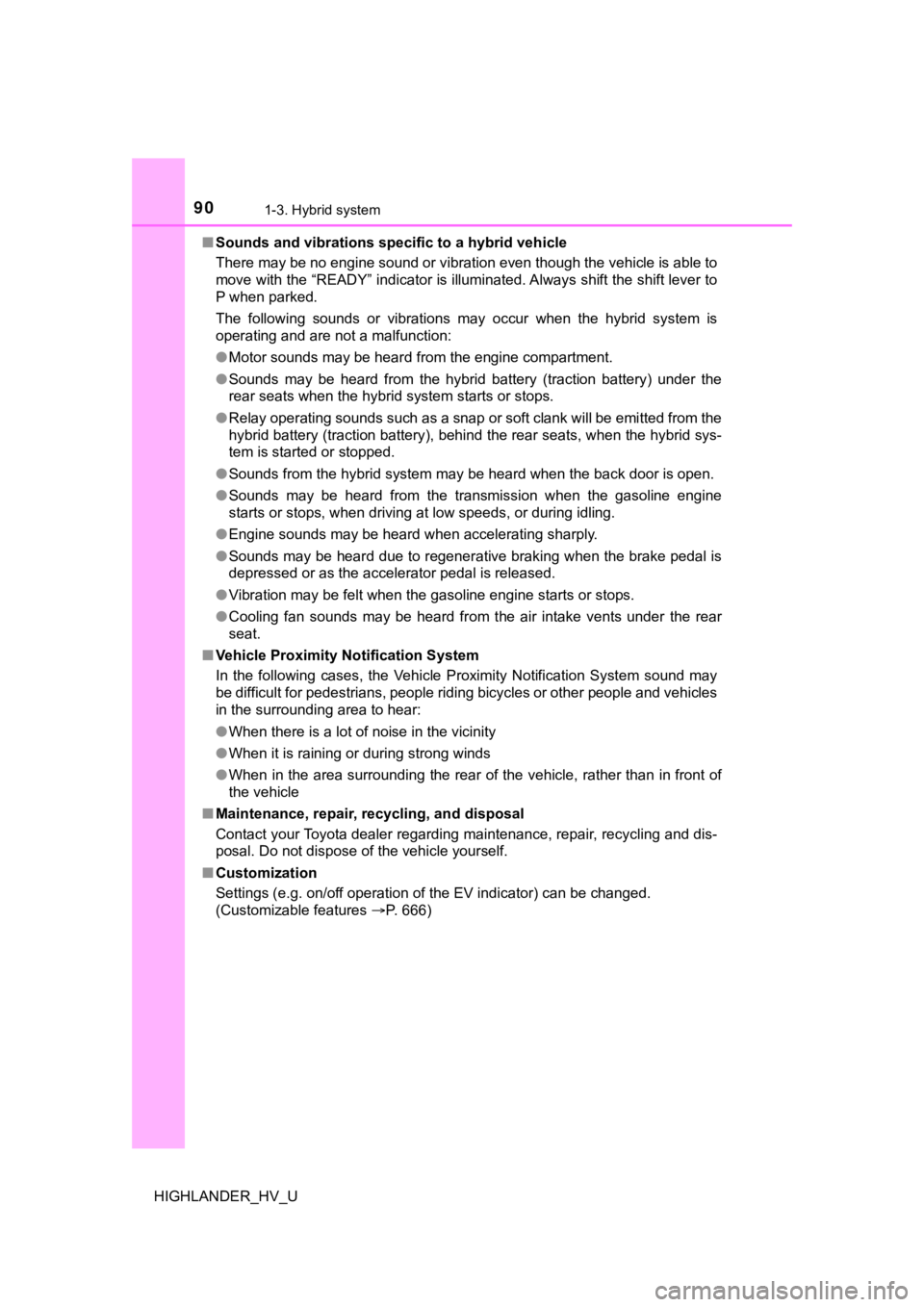
901-3. Hybrid system
HIGHLANDER_HV_Uâ–
Sounds and vibrations sp ecific to a hybrid vehicle
There may be no engine sound or vibration even though the vehic le is able to
move with the “READY” indicator is illuminated. Always shift the shift lever to
P when parked.
The following sounds or vibrations may occur when the hybrid sy stem is
operating and are not a malfunction:
â—Ź Motor sounds may be heard from the engine compartment.
â—Ź Sounds may be heard from the hybrid battery (traction battery) under the
rear seats when the hybrid system starts or stops.
â—Ź Relay operating sounds such as a snap or soft clank will be emi tted from the
hybrid battery (traction battery), behind the rear seats, when the hybrid sys-
tem is started or stopped.
â—Ź Sounds from the hybrid system may be heard when the back door is open.
â—Ź Sounds may be heard from the transmission when the gasoline engine
starts or stops, when driving at low speeds, or during idling.
â—Ź Engine sounds may be heard when accelerating sharply.
â—Ź Sounds may be heard due to regenerative braking when the brake pedal is
depressed or as the accelerator pedal is released.
â—Ź Vibration may be felt when the gasoline engine starts or stops.
â—Ź Cooling fan sounds may be heard from the air intake vents under the rear
seat.
â– Vehicle Proximity Notification System
In the following cases, the Vehicle Proximity Notification Syst em sound may
be difficult for pedestrians, people riding bicycles or other people and vehicles
in the surrounding area to hear:
â—Ź When there is a lot of noise in the vicinity
â—Ź When it is raining or during strong winds
â—Ź When in the area surrounding the rear of the vehicle, rather than in front of
the vehicle
â– Maintenance, repair, recycling, and disposal
Contact your Toyota dealer regarding maintenance, repair, recyc ling and dis-
posal. Do not dispose of the vehicle yourself.
â– Customization
Settings (e.g. on/off operation of the EV indicator) can be changed.
(Customizable features ď‚®P. 666)